

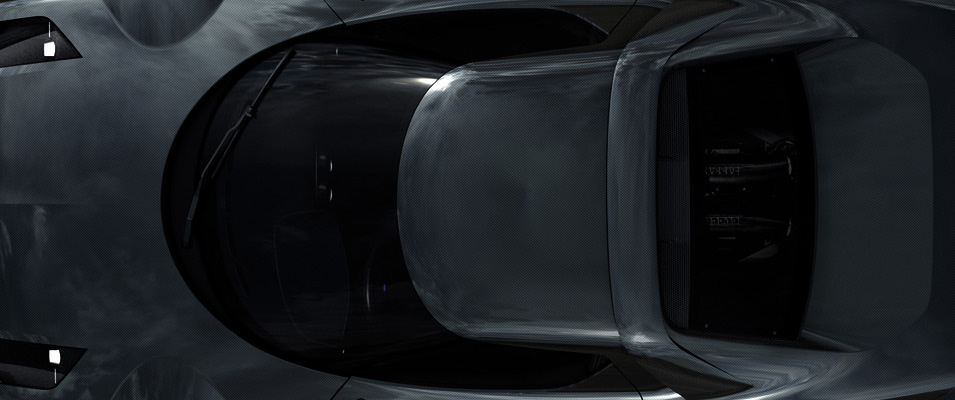







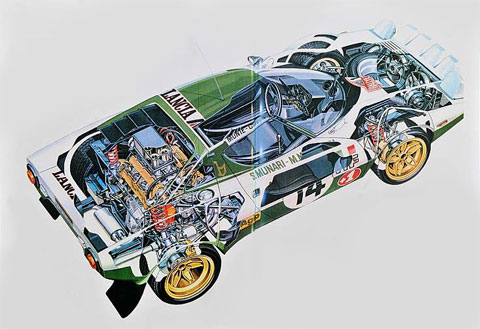
The legendary Lancia Stratos HF was without a doubt the most spectacular and successful rallye car of the 70s. With its thrilling lines and uncompromising design for rallye use, the Stratos not only single-handedly rewrote the history of rallyeing, it won a permanent place in the hearts of its countless fans with its dramatic performance on the world’s asphalt and gravel tracks. The Stratos still draws the crowds whenever it competes at historic motor sport events, thanks to its reputation as the most fascinating rallye car in the world.
It all began in 1970, at the Turin exhibition stand of the automobile designer, Bertone. The extreme Stratos study on display there – a stylistic masterpiece by the designer Marcello Gandini – didn’t just excite visitors, but caught the attention of Cesare Fiorio, Lancia’s team manager at the time… and refused to let go.
Just one year later, the Stratos assumed its final form when the mid-mounted V4 engine from the Lancia Fulvia was replaced by the significantly more powerful Ferrari Dino V6 engine. The road version of this “flounder” was just 1.08 meters high, mounted on a short steel chassis, and its aerodynamically sophisticated body was molded from reinforced fiberglass. The Stratos’ low weight, ideal weight distribution and excellent dynamics provided the optimum conditions for spectacular performance on the international rallye tracks, which at the time were still dominated by Alpine and Porsche. However, the results were not so immediately gratifying.
It was only when Lancia works driver Sandro Munari and British Formula 1 driver Mike Parkes got behind the wheel of the ruthless driving machine that success finally materialized. And it did so at lightning speed: in 1973 Sandro Munari took home the first victory for the Stratos HF, and the victories just kept coming in throughout 1974. By the end of 1976, the Stratos had pulled off a hat trick, winning three World Cup titles in a row.
The Italian “flying wedge” also enjoyed success beyond its works deployment: top driver Bernard Darniche brought home an incredible 33 victories for the private team Chardonnet of France, in his blue Lancia Stratos Chardonnet.
The Fiat group’s dramatic reduction of the Lancia racing budget in 1979, in favor of the Fiat 131 Abarth, was the death knell for the Stratos works team. From then on, only dedicated private teams took to the track competing against works cars – as in the 1981 Monte Carlo Rallye. Even today, there’s hardly any other vehicle that excites audiences at motor sport events like the Lancia Stratos.
A rare opportunity to tackle the Arosa hillclimb with Michael Stoschek in his Lancia Stratos Group 4.
But the story isn’t over yet.
In November 2010, 40 years after its first appearance at the Turin Motor Show, a successor to the ruthless flying wedge will be presented to a small circle of international motor sport journalists on the Paul Ricard Circuit.
The legend returns.
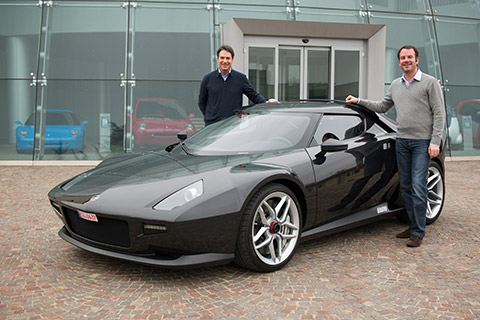
Michael Stoschek is a collector and driver of historic racing cars as well as a successful entrepreneur in the automotive supply industry. For Stoschek, the development and construction of a modern version of the Stratos represents the fulfillment of a long-held dream.
Construction of the car has been underway since autumn 2008, at Pininfarina in Turin, Italy. The contemporary New Stratos is a non-commercial project by Michael Stoschek and his son Maximilian Stoschek. Together they played a fundamental role in determining the technical concept and design of the one-off vehicle.
Michael Stoschek is chairman of the Brose Group shareholder's meeting. Brose is the fifth-largest family-owned company among global automotive suppliers.
A keen sportsman, Stoschek won the Carrera Panamericana in 1999, 2001 and 2004, and the 2006 FIA European Rallye Championship, driving a 1971 Porsche 911 in both races. The Lancia Stratos Group 4 has a special place amongst the historic rallye cars that Stoschek employs for rallies and hillclimbing. Sporting a Marlboro design, the vehicle has been restored over more than a decade, according to the specifications of the “1974 Tour de Corse Andruet/Biche” works car.
The decision to develop and build a new, ready-to-run Stratos was inspired by a meeting with Chris Hrabalek, with whom Michael Stoschek became acquainted at the 1986 World Stratos meeting organized in Alta Badia by Stoschek. This was also the impetus behind Stoschek’s involvement in the Fenomenon Stratos project, presented at the 2005 Geneva Motor Show, as well as his acquisition of the Stratos trademark rights.
In September 2008, Michael and his son Maximilian Stoschek commissioned Pininfarina to build a one-off vehicle the technical concept and design of which were largely determined by the two car enthusiasts.
A photographic feature about Michael Stoschek and his collection of historic rallye cars appeared in the 01/02 2010 issue of Rallye Magazine. You can download the German version in PDF format here.
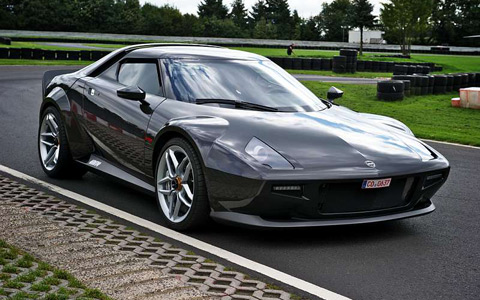
The Lancia Stratos’s fascination lay not only in its uncompromising construction – optimized for dedicated application in motor sport – but in its unparalleled design, the exceptional sound of the Ferrari V6 engine and naturally its remarkable success in competition. Up to that point, no sports car had been so systematically developed for racing use – indeed, the street version was merely a necessary evil for homologation.
The Lancia Stratos HF’s unique technical characteristics – the lightweight plastic body with integrated roll cage, the mid-engine, the racing transmission, the adjustable chassis for all applications, the two side tanks at the center of the vehicle, the integrated car door compartments for driver and front passenger helmets, the removable front and rear hoods for servicing and the separate engine access through a hatch – are all included in its successor’s specifications.
In this respect, the New Stratos is not a mere conversion of a Ferrari, but a newly developed, independent sports car that, as in the 1970s, integrates several components from the Fiat Group’s production vehicles.
The roll cage – made from 2.5 mm thick tubing, with a 40 mm diameter, and welded into the shortened aluminum chassis – has been manufactured to current FIA standards. This not only improves safety for the vehicle occupants, but also significantly enhances the handling precision.
Despite the cage structure and the built-in air conditioning, by keeping the body, interior and almost all the components lightweight, the weight of the base vehicle could be kept at an absolute minimum.
Overall, engine performance was only slightly increased; however, thanks to the New Stratos’ minimal weight, excellent balance and new set-up, the vehicle delivered a truly extraordinary performance and unbelievable driving pleasure.
Currently, the New Stratos is one of a kind. Whether or not an exclusive, limited run will be manufactured, depends upon demand.
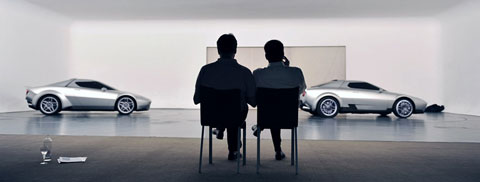
Creating a modern interpretation of a classic product is an exceptional challenge for a designer. It can be difficult to find the right balance between the issue of, on one hand, drawing too much from the original and, on the other, departing too much from the initial concept. It’s Michael Stoschek’s belief that the more perfect a classic form is, the less it should be changed – the Ford GT 40 offering a good example of this.
Particular caution is necessary when attempting a re-interpretation of a design icon like the Lancia Stratos. The radical Bertone study, with its futuristic design, was itself already well ahead of its time on its presentation in 1970. By holding to the premise "form follows function", Marcello Gandini smoothly paved the way for further development of the Stratos into a rally legend.
Michael Stoschek found it extremely fascinating to discover that, in addition to Chris Hrabalek, many renowned designers were inspired by the idea of a modern Stratos, and put their time and energies into helping him make his vision a reality.
Stoschek himself specified that, "because the design of the Lancia Stratos was characterized by the contrast between round and rectilinear elements, I wanted to see that tension to be carried over into the New Stratos as well."
The assignment was to find a contemporary interpretation for all the quintessential design characteristics of the Lancia Stratos, including:
the wedge-shaped body,
the semi-circular windshield,
the front end with its central radiator,
the rear end with its round tail lights,
roof and rear spoiler
and the five-star rims.
Since the project began in late 2008, all of Michael and Maximilian Stoschek’s, as well as Chris Hrabalek’s, conceptual and formal specifications for the body and interior have been implemented by Pininfarina.

Naturally, the theoretically pre-determined chassis components of the New Stratos will be reviewed via numerous road tests on both public and restricted roads, and high demands on handling singled-out accordingly.
To use the potential of the light, torsionally rigid and well-balanced vehicle to full advantage, the vehicle height, camber, toe and caster were redeveloped and, above all, the whole setup. Uniball joints and stiffer springs were employed, as well as a new damper calibration, allowing greater differentiation of the damping force, adjustable via the steering wheel. Optimum wheel / tire combinations were explored via testing of various tire brands, dimensions and rubber compounds. The Brose-sponsored, Portuguese WTCC pilot and former Formula 1 driver, Tiago Monteiro, contributed significantly to the chassis development together with the engineers from ZF Sachs.
WTTC and former Formula-1-Pilot Tiago Monteiro fine-tuning the chassis of the New Stratos at Balooco test track, Italy.
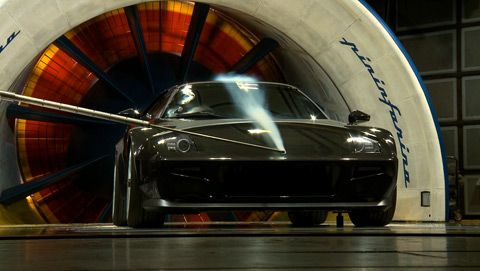
On September 13th, the final wind tunnel test was held at Pininfarina in Turin. The aerodynamic data already gleaned from the 1:1 model of the New Stratos, together with all the subjective driving impressions from the various test tracks, was compiled and applied to the optimization of the lift and downforce values.
The inflow conditions of a moving New Stratos at wind speeds of 140-200 km/h were realistically simulated on the wind tunnel’s "rolling road". Among other things, the body was configured to different height values and pitches, and the effect of these on the perfect balance of the contact pressure between the front and rear axles was measured. Various spoiler lips were also employed on the underbody, in order to increase the downforce on the front axle.
The New Stratos at the final wind tunnel test on September 13th at Pininfarina in Turin.
The success of these coordination efforts was evident upon evaluation of the measurement report at the end of the test day. The quality of both the surface and the body’s aerodynamic performance – including the airflow from the roof and rear spoiler – could also be verified.
The values optimized via the wind tunnel test will be applied to the calibration of the dampers and springs prior to the next test runs. In the coming days, the team of test drivers will review to what extent these modifications can further perfect the already excellent handling characteristics of the New Stratos on Balocco’s test and handling circuit.

The goal for the development of the Lancia Stratos HF’s successor was to once again create a mid-engine sports car with a short wheelbase, low weight and superior agility.
Just as the Lancia Stratos, with its Ferrari Dino V6 engine, was nevertheless a distinct sports car in its own right, the New Stratos is also a distinct development, using components of the Ferrari 430 Scuderia. Almost all of these components have been modified and, as necessary, customized to their new purpose. However, it should also be pointed out that the Ferrari Scuderia really sets the standard amongst the current super sports cars and, as such, provides an excellent base for the New Stratos.
The chassis, composed from aluminum extrusions, was shortened by 20cm and welded to a roll cage made of FIA-certified, 40mm-thick steel. This method significantly increases rigidity, and this, combined with the shifting of the center of gravity towards the front, provides the basis for the vehicle’s extraordinary handling characteristics. Both the body – which is 33cm shorter than the Scuderia’s – and the interior are constructed entirely of carbon fiber and aluminum.
The 4.3L V8 engine, which draws its intake air from the roof spoiler’s side openings, has been equipped with a new control unit and a high-performance exhaust system, including manifold and sports cat.
The 6-speed transmission received a new mechanical differential lock, and the modified control electronics allow for extremely fast gear changes at less than 60 milliseconds.
The chassis was completely reengineered, including integration of new electronic damper calibration, adjustable via the steering wheel, modified springs and optimized camber and toe values. The 9- and 11-inch wide by 19-inch center lock wheels are fitted with Michelin Pilot Sport Cup 2 tires, sizes 265/30/19 and 305/30/19.
The Brembo brake systems, comprised of 398mm-diameter ceramic discs and 6-piston calipers at the front axle, and 350mm-diameter and 4-piston calipers at the rear axle, are equipped with Brembo racing brake pads and steel flex lines.
Finally, the steering has been converted to electro-hydraulic, the new smaller steering wheel displays the shift points via multi-colored LEDs and the paddle shifters are from the Ferrari 430 racecar.
The battery is a lithium unit in a carbon casing, with a weight of 4.2kg and a capacity of 84 Ah.
Despite the approximately 55kg steel roll cage and the 28kg air conditioning unit – which it was necessary to take on due to the large glass surfaces – the New Stratos weighs about 80kg less than the base vehicle.
The New Stratos’ exceptional performance – the sum total of all these measures – will be gauged in the coming weeks and demonstrated through a standardized testing program which provides objective, reproducible data.
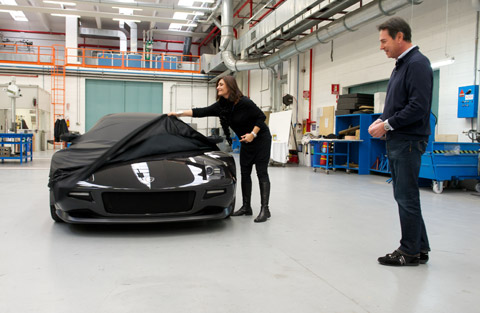
Turin. Monday, November 8th, 2010. Draped in black cloth, the New Stratos stands waiting in a Pininfarina production hall for its new owner. Work on the details – painting, polishing, etc. – has been underway up until the final hour. Now, at handover time, the automobile is near perfect.
A big kudos is due to the Pininfarina team, which after two years of hard work delivered a perfect car. Only upon reviewing the comprehensive photo documentation, can the amount of work that’s gone into the construction of this one-off vehicle be truly appreciated. Right down to the very last detail the finish is exceptional for an one-off car.
Engineers and technicians take the New Stratos for a few further short road tests around the Italian design company to make absolutely sure everything is in perfect working order. Adjustments are made once more; final details optimized. Then, at last, the glasses are raised, words of thanks exchanged, and the obligatory handover celebration goes on late into the night.
The following morning, the time has come: the New Stratos sets course for its new home – and although the highway isn’t the racecar’s preferred territory, it delivers some real driving pleasure right off the bat, on the first entry ramp.
In the coming days, the sports car will add several miles to the 3,000 test kilometers it clocked up in recent months at various racetracks and handling circuits. Final performance figures have to be determined, objective measurements transformed into verifiable data.
After all, there are only a few more weeks to go until the New Stratos’ presentation to the international press at the Paul Ricard Circuit… Two weeks – to be exact.
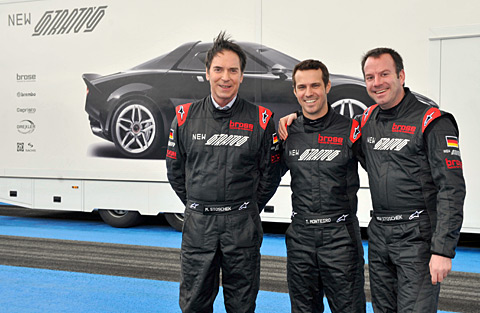
Since the first blurry pictures of New Stratos appeared on the Internet last summer, sports car enthusiasts and motorsport fans from around the world have been waiting impatiently for confirmation of whether the successor to the legendary Lancia Stratos really drives as impressively fast and with as much agility as appearances would suggest.
On November 29th and 30th, the time had come: Michael and Maximilian Stoschek invited a select group of journalists, designers, engineers, race and rally drivers to the premiere in Le Castellet, so they could at last experience the New Stratos live and in action. What’s more, the attendees were able to do so not merely from the passenger-side racing seat, but from behind the small sports steering wheel with the Manettino switch. After a few racing-style introductory laps from WTCC driver Tiago Monteiro and Maximilian and Michael Stoschek, New Stratos novices were permitted to personally catapult the 540 hp car onto the racetrack via the 6-speed sequential gearbox.
Not surprisingly, no one passed up on this opportunity, least of all Bernard Darniche, French and European rally champion many times over, and – with 41 victories – the most successful Lancia Stratos driver of all time. He sped his legendary victory car’s successor through the tight, twisty section of the Paul Ricard Circuit, just like in the old days. In an interview afterwards, Darniche left no doubt about his enthusiasm for the razor-sharp handling and seamless implementation of even the tiniest steering, brake and gas commands. Furthermore, the exceptionally high quality of workmanship for a one-off vehicle and the level of perfection to be found in every single detail, unanimously impressed the visiting press representatives.
During the dinner afterward, theory followed where practice left off: designers, suspension technicians, development engineers, project managers and, naturally, the initiators themselves, left no question about the New Stratos’ development unanswered in their entertaining lectures and individual conversations. No questions, that is, except the one regarding the possibility of a limited run. However, if demand is sufficient, this question may soon have an answer as well.
Interested parties are requested to direct enquiries to the following e-mail address: contact@new-stratos.com.
Impressions from the presentation of the New Stratos on the Circuit Paul Ricard on November 29th and 30th, 2010
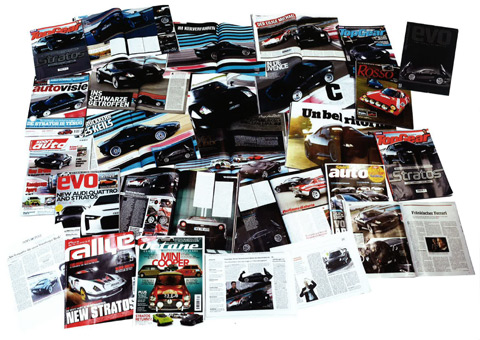
The media’s reaction to our presentation on November 29th and 30th 2010 was truly overwhelming.
Almost without exception, the major European and overseas car magazines placed the New Stratos on their covers, in most cases alone, and several featured comprehensive articles on the vehicle.
The New Stratos team was thrilled that the vehicle was voted the Best Sports Car of 2010, by readers of Classic Driver. The current issue of Auto Bild also voted it the third coolest car: the only one-off vehicle selected.
All those involved in the project were very proud of the media’s expert appraisal of both the concept and implementation of the New Stratos. Virtually every journalist recognized that developing a worthy successor to the Lancia Stratos was not a financially-motivated decision, rather a labor of love. To quote the project’s initiator, Michael Stoschek:
"Throughout my entire career, rarely have I witnessed a project where those involved contributed their services with so much pleasure and ambition."
The New Stratos’ quality and performance really comes down to the teamwork and involvement of competent partners. Logos of the companies that were especially supportive were displayed on the New Stratos’ side panels at the Paul Ricard Circuit presentation. The German company Capristo, based in Sundern, deserves particular mention. They developed the New Stratos’ entire exhaust system, continuously optimizing it on an engine test bench and then manufacturing it out of very thin stainless steel, from manifold to sport cats. The exhaust has a guaranteed shelf life of 20,000 kilometers and was installed in the vehicle completely free of charge.
A report published in a South German daily claiming that the exhaust is made of titanium, cost 80,000 Euros and lasts only 5,000 kilometers, is as false as the price they quoted for the titanium and aluminum bolts that we used (instead of steel) in the vehicle’s assembly.
It should also be mentioned that all the New Stratos’ indicators, as well as the entire dashboard, have been redesigned and expanded to include a G-meter and clock.
The Manettino switch in the new steering wheel was also reprogrammed for higher performance and, lastly, the New Stratos can, of course, also be driven without engaging any electronics. While this setting delivers the greatest driving pleasure, it does, however, also require adequate driving skills and reaction speed.
The New Stratos team hopes that the winter will soon be over so that the previously announced comparison tests with other sports cars can be carried out.
The New Stratos’ first motor sports deployment will be at the Rally Isla Mallorca, from March 10th-12th, 2011: www.rallyislamallorca.com. It will be the New Stratos’ first appearance in Spain. Driven by Michael and Maximilian Stoschek, it will lead the race class as the zero car. However, the rally auto used in the Rally Isla Mallorca will not look like the new Alitalia Stratos – a different design and auxiliary headlights are planned.
Several publications will be reporting on the tests taking place at the Circuito Llucmajor circuit, from March 7th-9th, as well as on the rally from March 10th-12th.
The New Stratos, like the racing version of its predecessor, has been extensively geared – down to every last detail – towards lightweight design and performance. Not surprisingly, the specification sheet was therefore extremely ambitious in this regard as well.
The low vehicle weight, the excellent balance and the precision chassis components made possible by the rigid body, were intended not only to provide an exhilarating driving experience, but to provide measurable results in the form of objective data.
As work on the New Stratos continued virtually without pause up until the presentation in Le Castellet, and weather conditions offered no opportunity for performance test runs, these will have be carried out at the next available opportunity.
We expect a power-to-weight ratio below 2.3 kg/hp with an acceleration time from 0-100 km/h of 3.3 seconds and from 0-200 km/h of 9.7 seconds. We expect top marks for braking performance and a benchmark position in the 18- and 36-meter slalom and similar handling tests.
After introducing the new rear axle ratio (crown wheel and pinion 9/45), the top speed will be reduced to 274 km/h, in order to achieve even better acceleration values.
Michael Stoschek and Dieter Hawranke on the city street circuit in Zwickau during the Sachsen Rallye 2011.
A lap with Maximilian Stoschek on the Circuit Spa Franchorchamps, 24.6.2011.
Following its official presentation at the Paul Ricard Circuit, the New Stratos will be presented this year at the IAA Frankfurt Auto Show and the CTI Conference on Lightweight Construction in Stuttgart.
IAA News: Small stand, big enthusiasm. Amongst the many attractions presented at the IAA 2011, there were only a few highlights rated "top" by journalists. The New Stratos came in third place on the survey and was the first car mentioned. View the full survey here.
The Lancia Stratos’ successor was developed on behalf of and under the direction of Michael und Maximilian Stoschek. Both are associates of the family-owned Brose Group, a global specialist in mechatronic products and electric drives for vehicles.
There are more than 2,000 engineers and technicians working for Brose on product and process innovations – and they enthusiastically embraced the New Stratos project. Efficiency, functionality and extremely light weight were the targets in the development of innovative solutions for the mechanics, electrics and electronics of:
- windows
- door locks
- door stops
- seat adjustment
- front and rear hood closures.
Not only was the New Stratos the focus of overwhelming media attention following its official presentation, it also received numerous accolades throughout 2010, including:
Car of the Year Award 2010: 1st place, sports cars (Classic Driver)
"Best Sports Car 2011" (Top Gear)
Coolest Cars Worldwide: 3rd place (Autobild)
From the 15th to the 25th of September 2011, the New Stratos will be on exhibit at the Frankfurt Auto Show. Interested parties are warmly invited to visit the Brose stand in Hall 4.0, in the Europa Room.
The New Stratos has the honor of being the only car being presented at the CTI’s International Conference on Lightweight Construction: "Efficient Lightweight Solutions", on the 26th and 27th of September 2011, in Stuttgart.
Michael Stoschek, Brose associate and initiator of the modern interpretation of the legendary 70s rally car, will give a lecture entitled, “The New Stratos – Building a Lightweight Sports Car”.
A high-performance sports car approved for road use, the New Stratos weighs – including its integrated roll cage made of FIA-certified steel tubing and air conditioning system – only 1,247 kg. This is due to the use of carbon fiber for the body and interior as well as the weight reduction of numerous mechanic systems and components from the donor vehicle, a Ferrari 430 Scuderia.
It’s worth mentioning that the Lancia Stratos Group 4 Rally car from 1974, also on exhibit, weighs in at merely 940 kg.
Highly concentrated: Michael and Maximilian Stoschek at the 16th Rally Isla Mallorca.
This year's Rally Clásico Isla Mallorca was a rare experience for all participants. The lockdown due to the Covid 19 pandemic was imminent, the rally was the last motorsport event in Europe for many months.
For Michael and Maximilian Stoschek, the 16th edition of this rally was a special experience for another reason as well: For the first time, they competed on New Stratos in alternating roles as driver and co-pilot.
The impressive video produced during this rally gives an excellent impression of this spectacular event, whose numerous special stages are crowned by Sa Calobra: An 11.46 km long special stage that starts just a few metres above sea level and then winds its way towards the finish in more than 50 sharp bends - 27 of which are hairpin bends - on a breathtaking asphalt track through narrow gorges and over numerous narrow bridges.
The enthusiasm among the spectators is great every time the New Stratos approaches the notorious Nus de Sa Calabro, one of the most famous curves in the world, at racing speed. The so-called "tie-knot" takes the road in a tight 270-degree bend underneath itself, before it passes through the rocky lunar landscape over a pass height of 682 metres.
Not only the spectators, but also the rally participants were thrilled by the design and dynamics of the New Stratos. The most famous among them this year was Jay Kay, rock star and world-famous car collector, who this year competed in a first series BMW M3. His résumé, after inspecting the New Stratos from all angles: "I would love to have one". Which I'm sure can be realized with the current construction of the small series by Paolo Garella of MAT in Turin.
https://www.manifatturaautomobilitorino.it/cars/new-stratos/
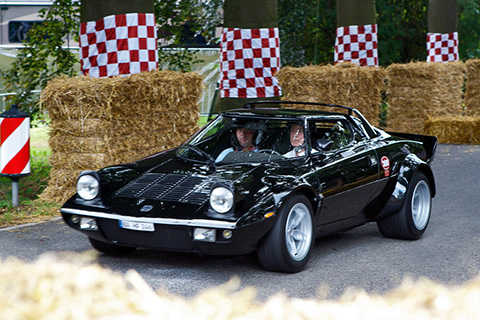
It's known as the German Goodwood in classic car and motorsport circles, and it's no wonder: Classic Days at Schloss Dyck is considered by many to be Germany's loveliest old timer and classic car festival.
With everything from rare pre-war cars to super sports cars and race cars, through to unusual concept vehicles on display, the festival draws auto enthusiasts – both spectators and participants – from all over Europe on the first weekend of August.
This year once again, Classic Days held to tradition with impressive line-ups and world-renowned cars featured in special runs on its 2.8 kilometer-long circuit. And among the vehicles invited this year were Michael Stoschek's two black Stratos': the Legendary Lancia Stratos Stradale and it's modern successor, the New Stratos. A tent was reserved for both in the castle complex's inner courtyard.
On both Saturday and Sunday, a special run was organized for these two show highlights, together with Dieter Castenow's Lancia Stratos HF. Amidst the applause from well-informed spectators and guests, the New Stratos demonstrated – via direct comparison with its predecessor – just how uncompromising implementation of the modern interpretation of this legendary race and rally classic really was.
Whether historical rally icon, or contemporary interpretation: it never ceases to fascinate how much enthusiasm these vehicles arouse. It started with the Lancia Stratos' first spectacular appearance on the international motorsport scene over 40 years ago – and it hasn't let up since. It even looks as though the New Stratos will help carry the ongoing fascination for the seminal rally sport icon into the future.
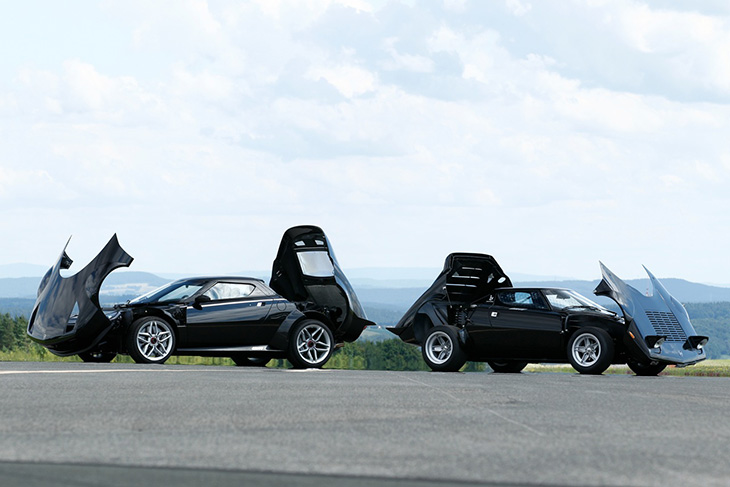
Black magic, this is the title of SPORTSCAR's March 2018 issue 1, an exciting juxtaposition of the Lancia Stratos and its successor New Stratos. You can read the exciting article, which was published to suit the presentation of the small series launch at the Geneva Motor Show, here (German).
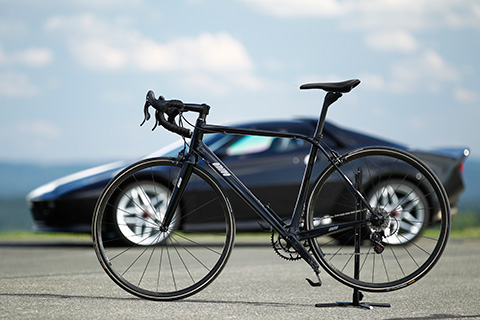
Until recently the New Stratos could only be experienced on four wheels. But because the weight of the frame and components is continually being reduced through the increased use of carbon as part of performance-oriented racer production, the sports-mad Michael Stoschek put together a two-wheeled version of the New Stratos.
The uncompromising racing bike was built with the same materials as the New Stratos, lending the extremely light and agile high-end sports vehicle a performance comparable to that of the legendary Stratos racecar. Even such details as the fiber structure, enamel and saddle covering correspond 1:1 to the New Stratos. And as with its four-wheeled inspiration, the powertrain derives from premium Italian craftsmanship: the Campagnolo Super Record group set combined with the rigid and superlight Monocoque frame ensures a quick start.
This unique handcrafted specimen was constructed by the German carbon specialists ax lightness, whose products influence not only international bike racing, but the world of Formula One as well.
| Weight | < 5 kg |
| Size | Determined individually by the driver |
| Group set | Campagnolo Super Record |
| Stem | Carbon, 110 mm |
| Handlebar | Carbon, 420 mm |
| Saddle support | Carbon, 23 mm offset, Length 360 mm |
| Saddle | Carbon, custom covering |
| Wheels | Carbon rims, 24 mm high |
| Crank set | Carbon, 30 mm axle |
| Brakes | Carbon, side cable control |
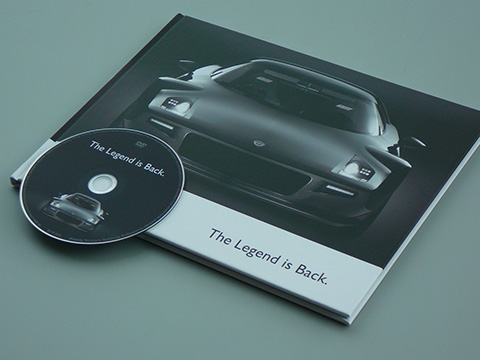
From the idea to the street-ready sports car:
In the more than five years since the beginning of the New Stratos, there have been a great number of impressive photos that seamlessly document each individual phase of development.
This collection of photographs has given rise to the idea for a book, in which more than 200 select photos provide fascinating insight into the development and manufacturing of this super sports car.
This photo book, produced in-house, is accompanied by a 20-minute DVD featuring a film on the history of the Stratos – from the dramatic rallies of its predecessor, the legendary Lancia Stratos, to the first sporting competitions for the New Stratos.
The book (German) cum DVD (English/German) is available in a limited edition for the cost price of € 25 plus postage (Germany € 4 and foreign countries € 8).
We request those interested to transfer this amount to the following bank account, while sending the exact delivery address in an email to contact@new-stratos.com. The package will then be promptly shipped.
New Stratos GbR
Account: 8 555 85 600
Commerzbank Coburg
Bank code: 783 400 91
IBAN: DE71 7834 0091 0855 5856 00
BIC: COBADEFFXXX
Please direct any questions to Nadine Möller at +49 9561 21 1594.

More than 100,000 motorsport enthusiasts made the pilgrimage to Trento this year to experience a terrific hillclimbing race classic: With a length of about 11 miles and over 200 curves and hairpin bends, the FIA Mountain Championship Race at Monte Bondone is not only the longest, but also the most spectacular hillclimbing race in Europe.
This year Michael Stoschek, who had already been on the podium twice on this demanding track, piloted his New Stratos from the start in the Adige Valley over a breath-taking sequence of curve combinations and hairpins to the finish line at an altitude of 1,650 meters where the modern successor of the legendary Lancia Stratos was received enthusiastically.
Another highlight of the weekend awaited the initiator of the New Stratos project in the service area: the surprising encounter with the first New Stratos from the limited production of 25 vehicles built by Manifattura Automobili Torino. Paolo Garella, founder of M.A.T. in Turin and then project manager for the development and construction of the New Stratos, brought the first production vehicle to Trento, where it was extensively tested around Monte Bondone by Michael Stoschek.
New Stratos meets New Stratos: After the race, the blue demo car was allowed to accompany Michael Stoschek's advance vehicle through a line-up of thousands of waving and cheering Stratos fans down from the finish to the service park.
We captured the highlights of this major racing event and the first encounter of the two New Stratos on video:
After countless TV appearances, you can finally meet a New Stratos in the real world. What's more, you can even drive it. The first examples of the limited small series have now been delivered to passionate Stratos enthusiasts.
These unique high-performance sports cars are built by Manufattura Automobili Torino, or MAT for short. Its founder Paolo Garella was already responsible for the development and construction of the first New Stratos by the two initiators Michael and Maximilian Stoschek at Pininfarina before he went independent with MAT. Today, highly innovative automotive projects are created here under his direction, ranging from luxury super sports cars with road approval to thoroughbred racing machines that race to the top of the world's toughest championships.
And it is here in Turin that the small series of the New Stratos, limited to 25 units, is also being built. "With the New Stratos, we are bringing back the exciting feeling of analog driving," explains Paolo Garella. "True to its legendary predecessor, it features an extremely powerful Ferrari engine, while being exceptionally lightweight and sporting a short wheelbase. This guarantees unparalleled agility and maneuverability. Its manual transmission and flat-plane crankshaft pay homage to a classic racing model from the 1970s, while the carbon bodywork evokes the modern technology and unique design of this rally legend."
Each New Stratos is a custom-built one-off, built with the precision of typical Italian automotive engineering and an incredible attention to detail. Anyone interested in one of the last remaining examples should contact Paolo Garella:
MAT Manifattura Automobili Torino s.r.l.
Via Valgioie, 8
10040 Rivalta di Torino, Italy
info@manifatturaautomobilitorino.com
https://manifatturaautomobilitorino.com
| Length | 4181 mm |
| Width | 1971 mm |
| Height | 1240 mm |
| Front track | 1668 mm |
| Rear track | 1701 mm |
| Wheelbase | 2400 mm |
| Front overhang | 968 mm |
| Rear overhang | 813 mm |
| Dry Weight | 1247 kg |
| Weight distribution | 44% front, 56% rear |
| Aluminium profile | Scuderia chassis, 20 cm shortened |
| Welded roll cage | FIA FE45 steel, 40 x 2.5 mm |
| Full carbon fiber body and interior | Visible carbon (Re Fraschini) |
| Cw (at 140km/h) | 0.357 |
| A | 2.07 |
| Cw x A | 0.738 |
| Cylinders | 8 |
| Engine capacity | 4308 cm³ |
| Engine control unit | Bosch, update |
| Exhaust | High-performance system with free-flow manifold and sports catalytic converter (Capristo) |
| Maximum power | 397 kW (540 hp) at 8200 rpm |
| Torque | > 519 Nm at 3750 rpm |
| Power-to-weight ratio | 2.3kg/hp |
| 6 speed sequential gearbox with mechanical variable differential (Drexler) | Fast gear changes at less than 60 milliseconds |
| Gear Ratio | 4.3 / 5.0 |
| Electronic suspension system CDC® (ZF Sachs) | |
| Spring front | Eibach, 90 N/mm |
| Spring rear | Eibach, 160 N/mm |
| Dampers | Hydraulic aluminium twintube shocks with electronic-controlled proportioning valves |
| Front/Rear axle | Hub SKF with central fixing |
| Center-lock rims size front | 9J x 19’’ EH2 (Fondmetal) |
| Center-lock rims size rear | 11J x 19’’ EH2 (Fondmetal) |
| Offset front rim | ET 38 |
| Offset rear rim | ET 5 |
| Tyres front | 265/30/19 (Michelin Pilot Sport Cup 2) |
| Tyres rear | 305/30/19 (Michelin Pilot Sport Cup 2) |
| Carbon disk front | 398 mm x 36 mm (Brembo) |
| Carbon disk rear | 350 mm x 34 mm (Brembo) |
| Brake caliper front | 6 pot |
| Brake caliper rear | 4 pot |
| Pads | XAS 4499 (Brembo) |
| Brake lines | Steel flex lines |
| Head lights | Bi-Xenon (Hella) |
| Rear lights | LED-Ferrari 599 |
| Front wiper system | 1 blade |
| Exterior mirrors | Electric switch and side indicator |
| Window regulator | Lightweight regulator with anti-trap technology (Brose) |
| Windshield and side windows | 3.76 mm and 4 mm thin window glass |
| 6-Point Harnesses, 3” Width (Willans) |
| Electro-hydraulic power steering pump | |
| New carbon steering wheel with multicoloured LEDs |
| 2 outboard aluminium fuel tanks, capacity 90 litres |
| 84 Ah Lithium Ion Battery in carbon housing, weight 4.2 kg |
| Engine control unit | |
| Window regulator (anti-trap) | |
| Electronic suspension system CDC® (ZF Sachs) | |
| Door locks and bonnets |
Press Release, March 6th, 2018: A long awaited comeback
PDF Download
Press Release, February 9th, 2018: Manufacturing Of A Limited Series
PDF Download
Press Release, December 10th, 2010
PDF Download
The press photos may be printed and published free of charge.
Michael Stoschek driving the New Stratos
Download
Michael Stoschek driving the New Stratos
Download
4,3 l V8 Ferrari engine delivering 540 hp and a torque of more than 519 Nm
Download
Maximilian Stoschek presenting the New Stratos
Download
Michael Stoschek
Download
Press inquiries should be sent to:
contact@new-stratos.com
We request that anyone interested in purchasing a New Stratos get in touch via the following email address:
contact@new-stratos.com
Once a decision has been made regarding the production of further vehicles, you will be notified by the manufacturer.
New Stratos GbR
Max-Brose-Straße 1
96450 Coburg
Mail: contact@new-stratos.com
We make every effort to keep the information on our Web site current, but accept no liability whatsoever for the content provided. Pursuant to §7 par. 1 of TMG (German Tele-Media Act), the law limits our responsibility as a service provider to our own content on these Web pages.
According to §§8 to 10 of TMG, we are not obligated to monitor third party information provided or stored on our Web site. However, we shall promptly remove any content upon becoming aware that it violates the law. Our liability in such an instance shall commence at the time we become aware of the respective violation.
Our site contains links to third-party Web sites. We have no influence whatsoever on the information on these Web sites and accept no guaranty for its correctness. The content of such third-party sites is the responsibility of the respective owners/providers.
At the time third-party Web sites were linked to ours, we found NO GROUNDS WHATSOEVER of any likely contravention of the law. We shall promptly delete a link upon becoming aware that it violates the law.
The content and works provided on these Web pages are governed by the copyright laws of Germany. Duplication, processing, distribution, or any form of commercialization of such material beyond the scope of the copyright law shall require the prior written consent of its respective author or creator.
Please be aware that there are inherent security risks in transmitting data, such as e-mails, via the Internet, because it is impossible to safeguard completely against unauthorized access by third parties. Nevertheless, we shall safeguard your data, subject to this limitation. In particular, personal information will be transmitted via the Internet only if it does not infringe upon third-party rights, unless the respective party has given its prior consent in view of such security risks. Accordingly, as the Web site provider, we shall not be held liable for any damages incurred as a consequence of such security risks or for any related acts of omission on our part.
We oppose the use of any available contact information by a third party for sending unsolicited advertisements. As the Web site provider, we reserve the express right to take legal action against unsolicited mailing or e-mailing of spam and other similar advertising materials.
Source: S&K Rechtsanwälte www.streifler.de
Last updated: 25 May 2018
We are delighted that you are interested in our website. We take the protection of personal information very seriously and pay close attention to this aspect in our online activities. The processing of your personal information by New Stratos GbR takes place in compliance with statutory requirements and – if necessary – based on your consent. The most important statutory basis for this is the European General Data Protection Regulation (GDPR). We also comply with all other applicable data protection legislation, in particular Germany’s Data Protection Act (Bundesdatenschutzgesetz, BDSG) and Telemedia Act (Telemediengesetz, TMG).
In the following we would like to inform you in detail about the applicable legal requirements, particularly those of the GDPR, concerning the processing of your personal data when you visit our website.
You are on the website “new-stratos.com”. New Stratos GbR (“New Stratos”) is responsible (the “controller”) for data processing associated with your use of the website.
When you visit our website, your browser contacts our web server to retrieve the pages you wish to visit. You generally do not need to register or identify yourself to use this function. However, our server uses your IP address to allocate requests and responses, which could potentially be used to identify you.
In particular, personal data such as your IP address is transmitted to our web server as part of an HTTP/S call. This connection data is processed by our web server to allow access to the website. In some cases form data may also be processed containing data you have entered.
In addition, the respective HTTP/S calls are logged in a log file. We use this file for technical troubleshooting as well as to block and resolve attacks on our systems. We also utilize the already saved log files to create reports that we use to optimize our websites. The actual analysis is always anonymous, i.e. through a pooling of call data and thus it is no longer possible to use the data to identify a person.
The legal basis of any processing of your data that takes place depends on the specific purpose of your visit:
Processing of log files takes place as a general rule based on our legitimate interests in accordance with Art. 6 para. 1 (f) GDPR. Our legitimate interest is to protect our plants and systems against attacks and, if necessary, to take legal action against attackers as well as to continue to develop our websites for commercial purposes.
It is not possible to use this website or its forms without processing your connection or form data.
As a general rule, processing is automatic. Our IT department has access to the log files. The competent internal departments use these files for the above mentioned purposes and, if necessary, the data is also transmitted to external recipients (in particular law enforcement agencies to prosecute attacks).
The log files are stored for 14 days. All other data is deleted immediately after executing the HTTP/S call.
On our site we offer the possibility to contact us by email and/or via a contact form. In this case the information you provide is stored for the purpose of processing your contact request and for any follow-up questions. If you contact us with a request or we contact you, we also process your personal data such as your name, address, phone number and the content of the communication for the purpose of exchanging information with you
The processing of your data as part of communication via the contact form or by email takes place on the basis of Art. 6 para. 1 (b) GDPR, provided the exchange is in conjunction with the initiation or performance of a contract with you.
For the remainder, the legal basis depends on the purpose of the exchange; Art. 6 para. 1 (f) GDPR (our legitimate interest, business correspondence or, for example, to answer requests related to data protection) will apply in most cases.
Your are not required to provide your data. However, communication by email or via the contact form is not possible without processing your personal data.
We only share your data internally with the department that is responsible for your request.
Your personal data is deleted when it is no longer required for the exchange of information with you. In some cases the data may be held longer on the basis of Art. 6 para. 1 (c) GDPR in conjunction with the applicable statutory retention periods (in particular in accordance with trade, tax and revenue law). In the case of business correspondence, this is usually six to ten years after the end of the year in which it is received.
Like virtually every other website, we use cookies and similar technologies. A cookie is a small text file consisting of letters and numbers that is stored on your device when you visit a website. A cookie contains information that is stored when you visit this website on your computer or mobile device for the duration of your visit (“session cookies”) or for a longer period of time (“permanent cookies”). When you visit pages on this website, our system – or another website that recognizes this cookie – can query the cookie. This makes it possible to distinguish your device from other devices when you visit our website.
More specifically, these cookies or similar technologies make it possible to save your user preferences or credentials for the duration of your visit or until your next visit or, for example, to offer you shopping cart or application functions across multiple pages of our website. Moreover, we use specific cookies to collect information about how visitors use our website, e.g. which pages were visited and the duration of the visits. Pseudonymized user profiles may be created for this purpose.
As far as it is not technically necessary for the services requested by you - which is indicated in each case - you can object to the use of cookies and the associated data processing at any time as follows according to § 15 para. 3 TMG or Art. 21 para. 1 GDPR:
We use cookies on our website new-stratos.com as part of the following processing:
We use the “Google-Analytics” service, which enables data traffic analysis for our website (web analytics). This helps us continuously improve the information and the design of our website. We use Google-Analytics for various purposes such as to analyze which sections and subpages of our website were visited – and how often and for how long – and where our users come from (other websites).
Google Inc. (1600 Amphitheatre Parkway, Mountain View, CA 94043, USA) processes different usage data for this purpose and assigns an anonymous identifier to it. Additionally, certain information of the operator of website from which you came to us (in particular the URL of the previous page, any related search engine, any related search terms) may be processed. This usage data is used to create non-personalized reports on the use of our website.
The storage of Google-Analytics-cookies takes place per Art. 6 para. 1 (f) GDPR. The website provider has a legitimate interest in analyzing user behavior in order to optimize his website and his advertising.
Your usage data will be shared on to Google Inc. within the scope of an order processing according to Art. 28 GDPR. There they are processed automatically on our behalf. In general, the evaluation options are only used internally by our IT and marketing team.
See table below.
You may reject (as per Section 15 (3) TMG or Art. 21 para. 1 GDPR)) data processing and the use of cookies at any time for the future or revoke your consent (as per Art. 7 Abs. 3 GDPR) as follows: Please refer to Section 7.
| Name | Purpose | Deletion |
|---|---|---|
| _ga | User identification | 2 years |
| _gid | User identification | 24 hours |
| _gat | Controlling access rates to Google Analytics | 1 minute |
| AMP_TOKEN | Client-ID for AMP-Token | 30 seconds to 1 year |
Further information on data protection and the processing of your personal data by Google-Analytics can be found here.
We secure our website and other systems with up-to-date technical and organizational measures to prevent your data from being lost, destroyed, accessed, modified or disseminated by unauthorized persons. When sending personal data, we make use of encryption technology to ensure extremely high levels of confidentiality. Our servers use various security mechanisms and permission processes to make unauthorized access difficult. You should keep your access information secret at all times and close your browser window once you have finished communicating with new stratos GbR. This will ensure that no one apart from you can access your personal data if you share your computer with other people.
If you would like to subscribe the Newsletter offered on the Website, we require an e-mail address and information from you, which allows us to verify that you are the owner of the e-mail address provided and that you agree to receive the Newsletter. Further data will not be collected or only on a voluntary basis. We use these data exclusively for the dispatch of the requested information and do not pass these on to third parties.
The data entered in the newsletter registration form will be processed exclusively based on your consent (Art. 6 para. 1 lit. a GDPR). You can revoke your consent to the storage of the data, the e-mail address and its use for sending the newsletter at any time, for example via the "unsubscribe" link in the newsletter. The legality of the data processing processes already carried out remains unaffected by the revocation.
Your newsletter data will be transmitted to CreateSend.ie (Byrne Ventures Ltd, Suite 1, Information Age Park, Ennis, Co. Clare, Ireland) within the scope of an order processing according to Art. 28 GDPR and processed there within the EU.
For more information, please visit https://www.createsend.ie/privacy-policy/
The data you provide us for the purpose of subscribing to the newsletter will be stored by us until you unsubscribe from the newsletter and deleted after you unsubscribe from the newsletter. Data stored by us for other purposes (e.g. e-mail addresses for the member area) remain unaffected by this.
If our company processes your personal data you have the following rights within the respective legal scope:
If the processing is based on consent that you have provided (Art. 6 para. 1 (a) or Art. 9 para. 2 (a) GDPR), you have the right to revoke your consent at any time. This shall not affect the lawfulness of processing carried out on the basis of consent prior to your revocation.
In addition, you have the possibility of sending a complaint to the competent regulatory agencies. For New Stratos GbR, Germany, this is Bayerisches Landesamt für Datenschutzaufsicht (BayLDA), Promenade 27, 91522 Ansbach, Germany, email: poststelle@lda.bayern.de.